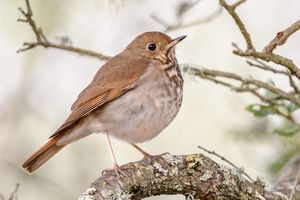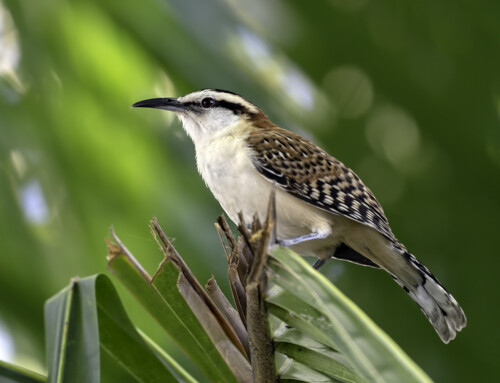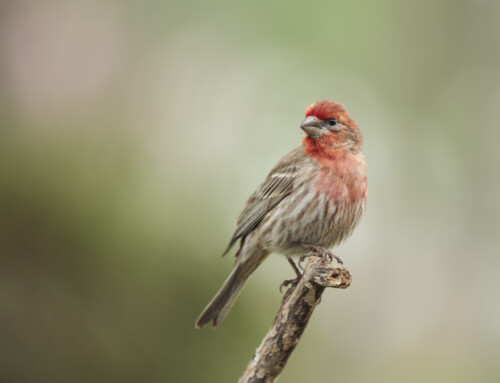 LINKED PAPER
LINKED PAPER
Vocal responses of Hermit Thrush (Catharus guttatus) males to territorial playback of conspecific song. DeMerchant, K. & Roach, S.P. 2021 Ibis. doi: 10.1111/ibi.13044 VIEW
As a birdsong researcher, one of my favourite topics is how territorial songbirds convey aggression. During the breeding season, male songbirds establish and defend territories while seeking out mates; communication related to both of these important goals happens primarily via song. Part of the reason that I enjoy studying this topic is because, when asked about my research, I can tell people that I piss off birds: researchers typically study territorial defence using song playback that makes it seem to the territory owner that a rival male is intruding. Besides that, though, I like it because it’s one of the most controversial topics within birdsong research, which much left to figure out. Indeed, although defending territories and conveying aggression represent one of song’s two central functions (along with mate attraction), little is known with certainty about exactly how song is used in that regard (Searcy and Beecher, 2009).
Researchers have explored a number of different singing behaviours that may be used to communicate aggression. These include song overlapping (when the male defending its territory overlaps, or interrupts, the song of its rival) and song matching (when the male responds to the rival’s songs with songs that are the same or similar). Another one, soft song, involves males singing quiet versions of their songs when faced with intruding males. I like to think of these behaviours in terms of their human counterparts: threatened territorial males may mimic their rivals (song matching), rudely cut them off (overlapping), or get very close and whisper, “Do we have a problem here?” (soft song). However counterintuitive it may seem that males get quieter in such situations, soft song is the one that has been most consistently demonstrated to be an aggressive signal in songbirds (Akçay et al., 2015).
Overlapping has been of particular interest to researchers lately: studies in some songbird species suggest that it may be an aggressive signal, with birds that respond more aggressively engaging in more overlapping. However, several recent studies have found that birds overlap less than would be expected by chance during such intrusions and that degree of overlapping is unrelated to – or even negatively associated with – degree of aggression. Instead of being related to aggression, changes to the timing of birds’ singing (as in overlapping less than expected by chance) may reflect the efforts of songbirds to avoid acoustic interference (Wilson et al., 2016).
We sought to add to this body of knowledge through a playback study with the Hermit Thrush (Catharus guttatus), a common North American songbird with a well-known song that is the stuff of legends. Recordings of unfamiliar hermit thrush males were broadcast on the territories of singing males in order to simulate territorial intrusions by rival males – the aforementioned pissing off of birds. We recorded the vocal responses of the subjects as they defended their territories against these supposed intruders.
The results revealed that most of the 17 subjects overlapped the playback recordings at levels below chance. That is, most of them actively avoided overlapping, even while busy exhibiting strong physical responses to playback like approaching the speaker and doing wing waves that are strongly linked to aggression. So, they did modify the timing of their songs – but not to overlap the intruder; rather, they appeared to adjust their singing to avoid the acoustic interference that would result from overlapping. We also found that males avoided matching playback songs, responding to high frequency playback songs with their own high frequency songs (or vice versa) much less often than would be expected by chance. This rarely documented avoidance of matching could also be a way to avoid acoustic interference, but that is not clear at this point.
Males changed not just how they used their songs but also the songs themselves. Hermit Thrush songs almost always consist of a whistled introductory note followed by a more complex and variable sequence of notes. During playback, the subjects did something they never did when singing spontaneously before playback: they often sang versions of their songs that had no introductory notes (Fig. 1). These unique songs, which we dubbed abridged songs, have only been observed in one other songbird: in the closely related Veery (C. fuscescens; Belinsky et al, 2015), males also frequently dropped the introductory parts of their song in response to playback.

Figure 1 Representative examples of broadcast repertoire songs from spontaneous singing (left) and their corresponding abridged songs recorded during the playback period (right).
That these abridged songs show up only in these aggressive situations raises the possibility that they are aggressive signals. Alternatively, it could again be a matter of efficiency, similar to song timing. It is likely that the introductory whistle – a structurally simple note that is resistant to degradation as it travels through the forest — serves a function related to long-range communication, as has been shown in some other songbirds. In contrast, more complex song components like the complex post-introductory part of Hermit Thrush song often serve more nuanced roles (e.g., individual identification). If so, abridged songs may simply be the result of males dropping a song component that is not relevant to the current, decidedly short-range nature of a territorial intrusion. We will soon do more field work – i.e., piss off more birds – in the interest of better understanding these abridged songs and their purpose.
References
Akçay, Ç., Anderson, R.C., Nowicki, S., Beecher, M.D., & Searcy, W.A. 2015. Quiet threats: soft song as an aggressive signal in birds. Animal Behaviour 105: 267-274. VIEW
Belinsky, K.L., Nemes, C.E., & Schmidt, K.A. 2015. Two novel vocalizations are used by Veeries (Catharus fuscescens) during agonistic interactions. PLoS One 10: e0120933. VIEW
Searcy, W.A., & Beecher, M.D. 2009. Song as an aggressive signal in songbirds. Animal Behaviour 78: 1281-1292. VIEW
Wilson, D.R., Ratcliffe, L.M., & Mennill, D.J. 2016. Black-capped chickadees, Poecile atricapillus, avoid song overlapping: Evidence for the acoustic interference hypothesis. Animal Behaviour 114: 219-229. VIEW
Image credit
Top right: Hermit Thrush © Becky Matsubara CC BY 2.0 Flickr.
If you want to write about your research in #theBOUblog, then please see here.




